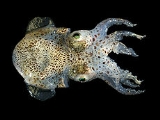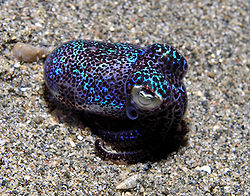
Bobtail squid
Encyclopedia
Bobtail squid are a group of cephalopods closely related to cuttlefish
. Bobtail squid tend to have a rounder mantle
than cuttlefish and have no cuttlebone
. They have eight suckered arms and two tentacles and are generally quite small (typical male mantle length being between 1 and 8 cm). Sepiolids live in shallow coastal waters of the Pacific Ocean
and some parts of the Indian Ocean
as well as in shallow waters on the west coast of the Cape Peninsula off South Africa. Like cuttlefish, they can swim by either using the fins on their mantle or by jet propulsion. They are also known as dumpling squid (owing to their rounded mantle) or stubby squid.
(Vibrio fischeri
), which inhabit a special light organ in the squid's mantle. The bacteria are fed a sugar and amino acid solution by the squid and in return hide the squid's silhouette
when viewed from below by matching the amount of light hitting the top of the mantle. The organ contains filters which may alter the wavelength
of luminescence closer to that of downwelling moonlight
and starlight; a lens
with biochemical similarities to the squid's eye to diffuse the bacterial luminescence; and a reflector
which directs the light ventrally.
), over her estimated one year long lifetime. The eggs are covered with sand and left without parental care. Symbiosis with V. fischeri from the surrounding seawater is initiated immediately upon hatching, and the bacteria's colonisation
of the juvenile
light-organ induces morphological
changes in the squid that lead to maturity
.
 There are about 70 known species. Sepiolid taxonomy within the coleoid
There are about 70 known species. Sepiolid taxonomy within the coleoid
cephalopods is currently controversial, thus their position is subject to future change.
Cuttlefish
Cuttlefish are marine animals of the order Sepiida. They belong to the class Cephalopoda . Despite their name, cuttlefish are not fish but molluscs....
. Bobtail squid tend to have a rounder mantle
Mantle (mollusc)
The mantle is a significant part of the anatomy of molluscs: it is the dorsal body wall which covers the visceral mass and usually protrudes in the form of flaps well beyond the visceral mass itself.In many, but by no means all, species of molluscs, the epidermis of the mantle secretes...
than cuttlefish and have no cuttlebone
Cuttlebone
Cuttlebone, also known as cuttlefish bone, is a hard, brittle internal structure found in all members of the family Sepiidae, commonly known as cuttlefish....
. They have eight suckered arms and two tentacles and are generally quite small (typical male mantle length being between 1 and 8 cm). Sepiolids live in shallow coastal waters of the Pacific Ocean
Pacific Ocean
The Pacific Ocean is the largest of the Earth's oceanic divisions. It extends from the Arctic in the north to the Southern Ocean in the south, bounded by Asia and Australia in the west, and the Americas in the east.At 165.2 million square kilometres in area, this largest division of the World...
and some parts of the Indian Ocean
Indian Ocean
The Indian Ocean is the third largest of the world's oceanic divisions, covering approximately 20% of the water on the Earth's surface. It is bounded on the north by the Indian Subcontinent and Arabian Peninsula ; on the west by eastern Africa; on the east by Indochina, the Sunda Islands, and...
as well as in shallow waters on the west coast of the Cape Peninsula off South Africa. Like cuttlefish, they can swim by either using the fins on their mantle or by jet propulsion. They are also known as dumpling squid (owing to their rounded mantle) or stubby squid.
Light organ
Bobtail squid have a symbiotic relationship with bioluminescent bacteriaBacteria
Bacteria are a large domain of prokaryotic microorganisms. Typically a few micrometres in length, bacteria have a wide range of shapes, ranging from spheres to rods and spirals...
(Vibrio fischeri
Vibrio fischeri
Vibrio fischeri is a gram-negative rod-shaped bacterium found globally in marine environments. V. fischeri has bioluminescent properties, and is found predominantly in symbiosis with various marine animals, such as the bobtail squid. It is heterotrophic and moves by means of flagella. Free living...
), which inhabit a special light organ in the squid's mantle. The bacteria are fed a sugar and amino acid solution by the squid and in return hide the squid's silhouette
Silhouette
A silhouette is the image of a person, an object or scene consisting of the outline and a basically featureless interior, with the silhouetted object usually being black. Although the art form has been popular since the mid-18th century, the term “silhouette” was seldom used until the early decades...
when viewed from below by matching the amount of light hitting the top of the mantle. The organ contains filters which may alter the wavelength
Wavelength
In physics, the wavelength of a sinusoidal wave is the spatial period of the wave—the distance over which the wave's shape repeats.It is usually determined by considering the distance between consecutive corresponding points of the same phase, such as crests, troughs, or zero crossings, and is a...
of luminescence closer to that of downwelling moonlight
Moonlight
Moonlight is the light that reaches Earth from the Moon. This light does not originate from the Moon, but from sunlight. The Moon does not, however, reflect sunlight like a mirror, but it reflects light from those portions of its surface which the Sun's light strikes. See diffuse reflection.In...
and starlight; a lens
Lens (anatomy)
The crystalline lens is a transparent, biconvex structure in the eye that, along with the cornea, helps to refract light to be focused on the retina. The lens, by changing shape, functions to change the focal distance of the eye so that it can focus on objects at various distances, thus allowing a...
with biochemical similarities to the squid's eye to diffuse the bacterial luminescence; and a reflector
Mirror
A mirror is an object that reflects light or sound in a way that preserves much of its original quality prior to its contact with the mirror. Some mirrors also filter out some wavelengths, while preserving other wavelengths in the reflection...
which directs the light ventrally.
Reproduction
Sepiolida are iteroparous and a female might lay several clutches, each of 1-400 eggs (dependent on speciesSpecies
In biology, a species is one of the basic units of biological classification and a taxonomic rank. A species is often defined as a group of organisms capable of interbreeding and producing fertile offspring. While in many cases this definition is adequate, more precise or differing measures are...
), over her estimated one year long lifetime. The eggs are covered with sand and left without parental care. Symbiosis with V. fischeri from the surrounding seawater is initiated immediately upon hatching, and the bacteria's colonisation
Colonisation
Colonization occurs whenever any one or more species populate an area. The term, which is derived from the Latin colere, "to inhabit, cultivate, frequent, practice, tend, guard, respect", originally related to humans. However, 19th century biogeographers dominated the term to describe the...
of the juvenile
Juvenile (organism)
A juvenile is an individual organism that has not yet reached its adult form, sexual maturity or size. Juveniles sometimes look very different from the adult form, particularly in terms of their colour...
light-organ induces morphological
Morphology (biology)
In biology, morphology is a branch of bioscience dealing with the study of the form and structure of organisms and their specific structural features....
changes in the squid that lead to maturity
Sexual maturity
Sexual maturity is the age or stage when an organism can reproduce. It is sometimes considered synonymous with adulthood, though the two are distinct...
.
Classification

Coleoidea
Subclass Coleoidea, or Dibranchiata, is the grouping of cephalopods containing all the primarily soft-bodied creatures. Unlike its sister group Nautiloidea, whose members have a rigid outer shell for protection, the coleoids have at most an internal bone or shell that is used for buoyancy or support...
cephalopods is currently controversial, thus their position is subject to future change.
- CLASS CEPHALOPODACephalopodA cephalopod is any member of the molluscan class Cephalopoda . These exclusively marine animals are characterized by bilateral body symmetry, a prominent head, and a set of arms or tentacles modified from the primitive molluscan foot...
- Subclass Nautiloidea: nautilus
- Subclass ColeoideaColeoideaSubclass Coleoidea, or Dibranchiata, is the grouping of cephalopods containing all the primarily soft-bodied creatures. Unlike its sister group Nautiloidea, whose members have a rigid outer shell for protection, the coleoids have at most an internal bone or shell that is used for buoyancy or support...
: squidSquidSquid are cephalopods of the order Teuthida, which comprises around 300 species. Like all other cephalopods, squid have a distinct head, bilateral symmetry, a mantle, and arms. Squid, like cuttlefish, have eight arms arranged in pairs and two, usually longer, tentacles...
, octopusOctopusThe octopus is a cephalopod mollusc of the order Octopoda. Octopuses have two eyes and four pairs of arms, and like other cephalopods they are bilaterally symmetric. An octopus has a hard beak, with its mouth at the center point of the arms...
, cuttlefishCuttlefishCuttlefish are marine animals of the order Sepiida. They belong to the class Cephalopoda . Despite their name, cuttlefish are not fish but molluscs....
- Superorder DecapodiformesDecapodiformesDecapodiformes is a superorder of Cephalopoda, which includes all species with ten limbs; the name derives from the Greek word meaning ten feet. The ten limbs are divided into 8 short arms and 2 long tentacles. It is presumed that an ancestral coleoid had five identical pairs of limbs, and that one...
- ?Order †BoletzkyidaBoletzkyidaThe Boletzkyda are perhaps the very earliest of the teuthid coleoid cephalopods, which seem to form a link between nautiloid orthocerids and more advanced coleoids. The Beletzkyda was named and described by Bandel, Reitner, and Sturmer in 1983 from specimens found the Lower Devonian black slate...
- Order SpirulidaSpirulidaSpirulida is an order of cephalopods comprising one extant species and several extinct taxa.-Classification:*Order Spirulida**?Family Shimanskyidae**Suborder †Groenlandibelina***Family †Groenlandibelidae...
: Ram's Horn Squid - Order Sepiida: cuttlefish
- Order Sepiolida: bobtail squid
- Family IdiosepiidaeIdiosepiidaeIdiosepius is a genus of bobtail squid encompassing around eight species. It is the sole genus of the family Idiosepiidae.Members of this genus represent no interest to commercial fisheries.-Species:*Idiosepius biserialis...
- Family SepiolidaeSepiolidaeSepiolidae is a family of bobtail squid encompassing 15 genera in three or four subfamilies....
- Family Idiosepiidae
- Order Teuthida: squid
- ?Order †Boletzkyida
- Superorder OctopodiformesOctopodiformesOctopodiformes is a superorder of the subclass Coleoidea. It comprises the octopuses and the vampire squid. All members of Octopodiformes have 8 arms.-Classification:*Class Cephalopoda**Subclass Nautiloidea: nautilus**Subclass †Ammonoidea: ammonites...
- Superorder Decapodiformes

